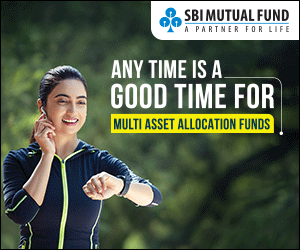The best performing income fund in the last 5 years: ICICI Prudential Long Term Plan

In the month of February 2016, the Government announced new small savings scheme rules, which has come into effect from April 1, 2016. Under the new rules, investors in small savings schemes like Public Provident Fund, National Savings Certificates, Senior Citizens Savings Scheme, Post Office Monthly Income Scheme, Kisan Vikas Patra etc will earn considerably lower income than before. The interest rates of all the government small savings schemes have been revised downwards by 0.6 to 0.75%. Under the new rules, the interest rates will be revised every quarter, based on the previous 3 month yields of the benchmark Government Bonds. In the current interest rate regime, it is expected that the interest paid by these schemes will go down even further. Major Banks have already reduced their Fixed Deposit interest rates to around 7.5%. Since Government small savings schemes and bank fixed deposits are preferred investment choices for a large number of Indian households, reduction in interest rates will have an adverse impact on the income of these investors.
When interest rates and Government bond yields go down, the interest rates of the small savings schemes also go down on a quarterly basis. On the other hand, when interest rates are lower, long maturity bond investors get higher returns from the capital appreciation of bonds. When interest rates decline bond prices increase and income funds which invest in long maturity bonds are great fixed income investment options for investors in a declining interest rate regime.
Income funds invest in a variety of fixed income securities such as bonds, debentures and government securities, across different maturity profiles. ICICI Prudential Long Term Plan is the best performing income fund in the last 5 years (please see Top Performing Income Funds in our MF Research Section). While in the last 5 years, most Government Small Savings Schemes paid interest @ 8.5 – 8.7%, ICICI Prudential Long Term Plan gave more than 11% compounded annual returns.
Please see the trailing annualized returns of ICICI Prudential Long Term Plan and Dynamic Bond Fund Category over the last 1, 3 and 5 years in the chart below (as on June 13, 2016).

Source: Advisorkhoj Research
You can see that ICICI Prudential Long Term Plan has outperformed dynamic bond funds category by a significant margin across all time-scales.
Please see the annual returns of ICICI Prudential Long Term Plan and Dynamic Bond Fund Category over the last 5 years.
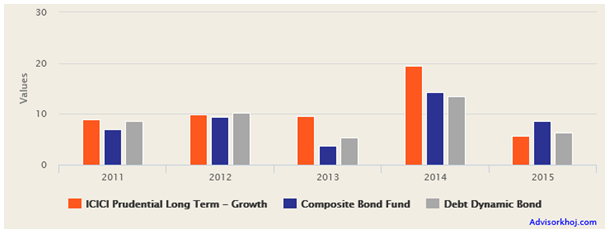
Source: Advisorkhoj Research
What are Dynamic Bond Funds
Dynamic bond funds like many other income funds invest in a portfolio of government and corporate bonds. However, unlike other income funds, in dynamic bond funds, the fund manager has the flexibility to actively manage the duration of his or her portfolio, depending on the fund manager’s outlook on interest rates. Bond prices rise when interest rates fall and fall when interest rate rises. Long duration bonds are more sensitive to interest rate movements compared to short duration bonds. If the fund manager believes that interest rates will fall in the future then he or she will invest in long duration bonds to take advantage of price appreciation of the bonds. If the fund manager expects interest rates to rise, then he or she will invest in short duration bonds, which will limit interest rate risk.
Therefore, dynamic bond funds can give good returns in a lower interest environment, while limiting downside during periods of rising interest rates. As such these funds are ideal long term debt investments for retail investors who want to profit from interest rate movements but are unclear about the trajectory and timing of the movements. You can rely on the expertise of the fund manager to make the right call.
Fund Overview
We believe that consistency of performance should be an important consideration when selecting a dynamic bond fund. Consistency of performance shows the dynamic bond fund manager’s ability to manage the portfolio duration, and therefore returns, in different interest rate scenarios. The 3 year rolling returns chart over the last 5 years shows why ICICI Prudential Long Term Plan is rated as a top performer. We have selected 3 years as the rolling returns period, since one should have a long investment horizon for income funds.
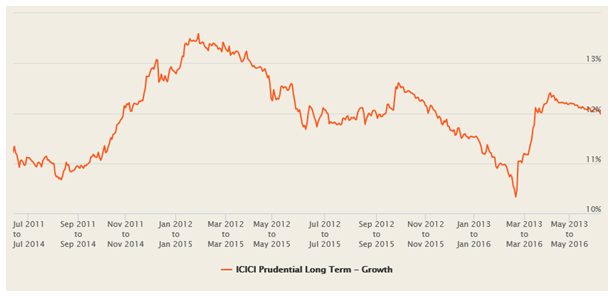
Source: Advisorkhoj Rolling Returns Calculator
In the last 5 years, we had periods of both rising and falling interest rates, but you can see in the chart above that ICICI Prudential Long Term Plan has always given more than 10% 3 year rolling returns over the past 5 years.
In other words, if you had invested at any point of time in the last 5 years, with a three year investment horizon, you would have always got double digit returns. There is a perception among many retail investors that all income funds are risky. The notion of risk among retail investors is very subjective, often based on what others are saying or by their own biases and not informed by actual data. As you can see that, in the last 5 years, irrespective of interest rate scenarios in the intervening periods, ICICI Prudential Long Term Plan delivered strong returns over a three year period, much higher than risk free fixed income investments.
Some retail investors think income funds are risky. Investors should understand that, while dynamic bond funds are subject to interest rate risks, if they have a sufficiently long investment horizon, encompassing interest rate cycles, there will be periods when these funds will underperform versus fixed deposits and other assured return products, but there will also be periods when these funds will outperform assured return products. Over a three year or more investment horizon, irrespective of interest rate scenarios, given the fact that dynamic bond funds are actively managed, these funds can be expected to deliver superior returns. Further, over a three year investment horizon, debt funds enjoy significant tax advantage over fixed deposits.
ICICI Prudential Long Term Plan was launched in May 2009 and has over र 850 crores of assets under management. The expense ratio of the fund is 1.22%. Manish Banthia and Anuj Tagra are the fund managers of ICICI Prudential Long Term Plan. The chart below shows the growth of र 100,000 lump sum investment ICICI Prudential Long Term Plan over the last 5 years.
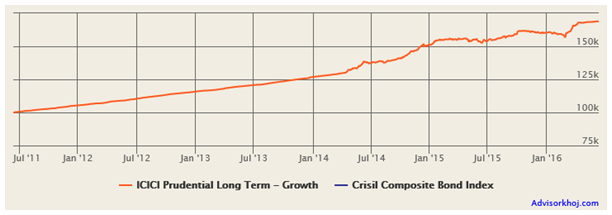
Source: Advisorkhoj Research
In the last 5 years you could have made a profit of nearly र 68,700 on an investment of र 100,000. The annualized returns would be over 11%. Morningstar has a 5 star rating for this fund.
Portfolio Construction of ICICI Prudential Long Term Plan
We had discussed earlier that fund managers of Dynamic Bond Funds actively manage the portfolio maturity and duration, depending on their outlook on interest rates and bond yields. Therefore the portfolio construction can change a lot from time to time, depending on the strategy of the fund manager. Currently, 91% of the portfolio of ICICI Prudential Long Term Plan is invested in Government Securities, about 8% in money market instruments and 1% in Corporate Bonds. The average maturity of the portfolio is 14.8 years.
It is clear from this portfolio construction that the fund manager is expecting interest rates and bond yields to decline. The yield to maturity of the portfolio is 7.9% and the modified duration of the portfolio is 7.8 years. Yield to maturity is the annual returns the fund will get by holding the bonds in its portfolio to maturity. Modified duration is the change in bond price for a 1% change in interest rate or yield. Therefore, if interest rates go down by 50 bps in the next 1 year, the price of the bonds in the portfolio of ICICI Prudential Long Term Plan will increase by 3.9%. This price appreciation is over and above what the fund will earn in terms of yields from their bonds during the year.
Therefore, in very simple terms, if interest rates go down by 0.5%, the fund can give 11.8% returns (7.9% + 3.9%) before expenses. Even after deducting expenses (expense ratio of 1.22%), the fund can give double digit returns if interest rates decline by 0.5%. This analysis is purely illustrative to show you how the concepts of yield to maturity and modified duration work. The actual returns of the fund will depend on a variety of factors. Reduction in repo rates may or may not result in a reduction of interest rates by the same amount. In fact, bond yields have softened a bit already in anticipation of the rate cut. There are a number of macro-economic risk factors, both local and global. The portfolio construction itself can change during the year and that will have an impact on returns.
Tax Advantage of Income Funds held for over three years
Over an investment horizon of three years or more, Income funds enjoy a big tax advantage over fixed deposits and many Government Small Savings Schemes. While fixed deposit and most government savings schemes interest is fully taxable, the debt fund profits over a three year investment period are taxed at 20%, after allowing for indexation benefits. The table below shows the post tax returns of ICICI Prudential Long Term Plan over various 3 year investment periods compared to FD post tax interest (based on prevailing FD interest rates for respective periods).
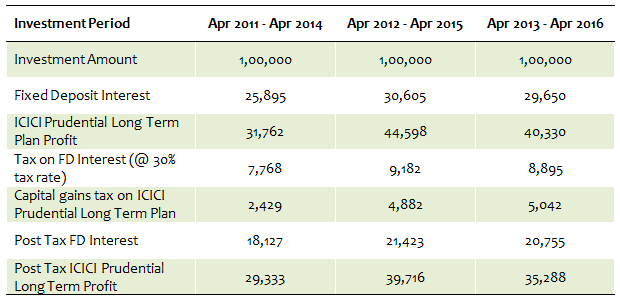
Source: Advisorkhoj FD versus Debt Funds comparison tool
To compare the post tax returns of this fund with FD interest over various time periods, please check our FD versus Debt Fund tool
Conclusion
The consistent performance of ICICI Prudential Long Term Plan makes it a good investment option for long term debt investors. To take full advantage of interest rate cycle and the tax advantage of debt mutual funds, investors should have at least a 3 year horizon for investing in the fund. Investors should consult with their financial advisors if ICICI Prudential Long Term Plan is suitable for their financial needs.
Mutual Fund Investments are subject to market risk, read all scheme related documents carefully.
Queries
-
What is the benefit of mutual fund STP
Aug 29, 2019
-
How much to invest to meet target amount of Rs 2 Crores
Aug 26, 2019
-
Can I achieve my financial goals with my current mutual fund investments
Aug 24, 2019
-
Can you tell me return of various indices
Aug 19, 2019
-
What would be the post tax return on different investments
Aug 18, 2019
-
Which Principal Mutual Fund scheme will be suitable for my retirement corpus
Aug 16, 2019
-
What is the minimum holding period for availing NCD interest
Aug 4, 2019
Top Performing Mutual Funds
Recommended Reading
Fund News
-
DSP Mutual Fund launches DSP Nifty Next 50 ETF
Dec 19, 2025 by Advisorkhoj Team
-
DSP Mutual Fund launches DSP Nifty 500 Index Fund
Dec 19, 2025 by Advisorkhoj Team
-
Kotak Mahindra Mutual Fund launches Kotak Nifty Next 50 ETF
Dec 18, 2025 by Advisorkhoj Team
-
The Wealth Company Mutual Fund launches The Wealth Company Gold ETF
Dec 16, 2025 by Advisorkhoj Team
-
Axis Mutual Fund launches Axis Gold and Silver Passive FOF
Dec 10, 2025 by Advisorkhoj Team




